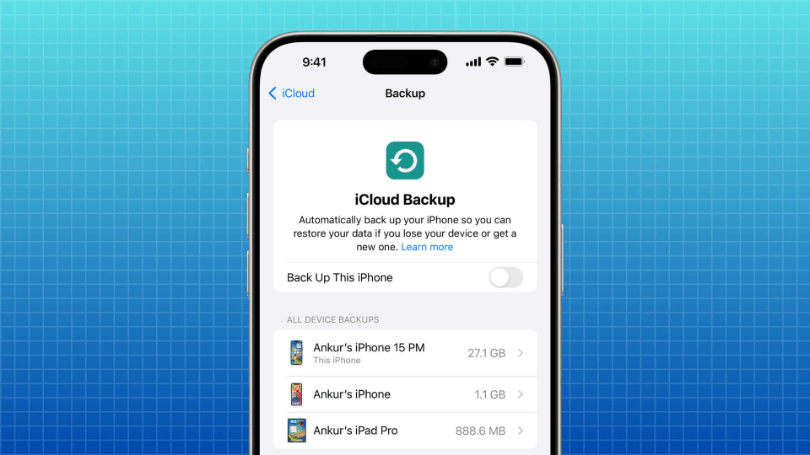iCloud backups are essential for data security, but they can eat away at your storage space. This guide unveils how to stop iCloud backup on your device, be it an iPhone, iPad, or Mac. Regain control over your storage and ensure backups only for the data you truly need. Follow our step-by-step instructions to free up precious iCloud space without compromising your device's safety.

Our images, films, and papers are valuable digital assets in today's digital world. Apple's iCloud backups offer a practical way to protect this information. But over time, these backups can mount up, creating the annoying situation of having all of your iCloud storage used up. You may be thinking, "Can I stop iCloud backups?" if you're in this situation.
Sure, but there is a catch to that answer. While turning off backups entirely isn't ideal (data security is vital!), there are some circumstances in which it might be a temporary fix, or there are particular data types you can omit. With the help of this article, you will be able to manage your storage effectively and navigate iCloud backups.

The Benefits of iCloud Backups:
Imagine losing your phone along with all of the priceless memories that are kept on it. iCloud backups serve as a kind of internet security. All of the data on your device—photos, videos, contacts, messages, and app data—is immediately duplicated. You may quickly transfer your data to a new device in the event of theft, damage, or device loss. This mental tranquility is priceless.
The Downside of Backups: Storage Constraints:
The free iCloud storage tier offered by Apple is a mere 5GB. While seemingly adequate initially, photo and video libraries can quickly devour this space. Once you reach your storage limit, iCloud backups grind to a halt, potentially putting your data at risk if not addressed.
Limited iCloud Storage Space:
This is the most common scenario for wanting to stop iCloud backups. If you receive a notification about reaching your storage limit, consider your options. Disabling backups entirely might seem tempting, but remember, it leaves your data vulnerable. A better approach might be to explore alternative storage solutions (more on that later).
Pausing Backups for Temporary Relief:
Perhaps you're anticipating a surge in photo-taking during an upcoming vacation. Temporarily disabling backups can free up space for those new memories. Remember to re-enable backups once your storage situation allows.
Switching to Alternative Backup Solutions:
There are various cloud storage providers offering free and paid storage tiers. If iCloud's limitations no longer suit your needs, consider exploring these alternatives.
1. Launch the "Settings" app on your iPhone or iPad.
2. Tap on your Apple ID banner at the top of the screen.
3. Select "iCloud" from the list of options.
4. Scroll down and tap on "Manage Storage".
5. Choose "Backups" from the storage breakdown list.
6. Select the device for which you want to disable backups (likely your iPhone or iPad).
7. Tap on "Turn Off Backup".
8. Confirm your choice by tapping "Turn Off & Delete" in the pop-up window. This will disable future backups and remove the existing backup for this device from iCloud storage.
While completely disabling backups might seem drastic, you can achieve some relief by selectively excluding specific data types from iCloud backups.
1. Follow steps 1-3 mentioned above (Settings > Apple ID > iCloud).
2. Instead of "Manage Storage", tap on "Photos".
3. Toggle the switch for "iCloud Photos" to the "Off" position. This will disable future photo backups but keep existing photos in iCloud.
4. Return to the previous menu and tap on another data category (e.g., "Contacts," "Notes"). Here, you can choose to disable individual app backups.
1. Open "System Preferences" on your Mac.
2. Click on "Apple ID".
3. Select "iCloud" from the sidebar.
4. Click on "Options" next to "iCloud Backup".
5. Uncheck the box next to the data type you want to exclude from backups (e.g., Photos, Desktop & Documents).
6. Alternatively, deselect the entire "Back Up Now" checkbox to disable all backups entirely. Remember, this is not recommended for long-term data security.
If you use iCloud for Windows to manage your iCloud account on a Windows PC, follow these steps:
1. Open "iCloud for Windows".
2. Click on "Options".
3. Navigate to the "Backup" tab.
4. Uncheck the box next to the data type you want to exclude from backups.
5. Alternatively, deselect the entire "Back Up Now" checkbox to disable all backups.
Upgrading Your iCloud Storage Plan:
Apple offers various paid iCloud storage tiers, ranging from 50GB to 2TB. Upgrading your plan provides a more sustainable solution compared to completely disabling backups.
Utilizing Selective Backups for Specific Data:
As mentioned earlier, you can exclude specific data types (like less frequently used apps) from iCloud backups. This helps optimize your storage usage and frees up space for essential data.
Exploring Alternative Cloud Storage Providers:
Several cloud storage providers offer competitive pricing and generous free storage tiers. Platforms like Google Drive, Dropbox, and Amazon Photos might be suitable alternatives to iCloud, depending on your needs. >> There is the best way to move iCloud data to other cloud services, that is to use MultCloud.
Remember, the key is to find a balance between storage efficiency and data security. Disabling backups entirely should be a last resort.
iCloud backups are a vital tool for safeguarding your valuable data. However, managing iCloud storage can be a juggling act. By understanding the benefits and drawbacks of backups, and exploring alternative storage management strategies, you can ensure your data is secure without constantly battling storage limitations.
This guide has equipped you with the knowledge to:
Remember, the best approach prioritizes a balance between convenience and security. By implementing the strategies outlined above, you can ensure your data is protected without sacrificing your iCloud storage space.